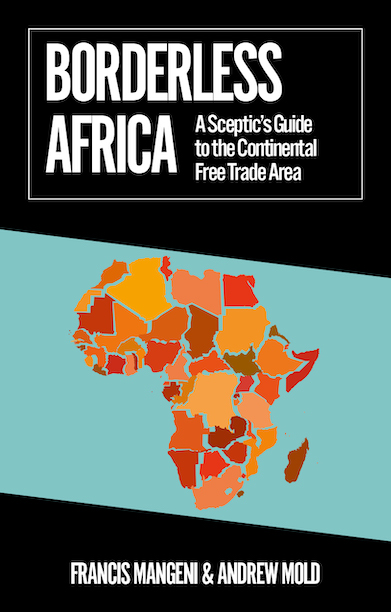
Our Projects are
Transforming African Trade
Quick Contacts
2nd Floor, Fidelity Insurance Centre Waiyaki Way, Westlands

Since its establishment at the African Union meeting in Kigali in March 2018, much ink has been spilt and much media attention has been heaped upon the African Continental Free Trade Area (AfCFTA). Yet a lot of misconceptions persist. Borderless Africa was written essentially to clarify those misconceptions and to reemphasise the political economic case for the AfCFTA. We advance the argument that if it wants to achieve its long-term developmental goals, Africa no longer has any viable strategic alternative but to accelerate continental integration under the aegis of the AfCFTA.
Despite its name, the AfCFTA actually goes well beyond the creation of a free trade area – it is about forming a continental market. Yet the wording ‘free trade’ understandably provokes adverse reactions in certain quarters, as it is often associated with economic liberalisation programmes of the 1980s and 1990s – ‘Structural Adjustment Programmes’ – that caused a lot of economic pain in Africa with very little gain. However, the critics are guilty of making a false equivalence – if it were true that the AfCFTA were a neoliberal project, then all attempts at regional integration would be open to the same accusation.
In fact, the AfCFTA is firmly grounded in longstanding pan-African ideas of how to achieve greater unity among African countries. This goes beyond the usual names associated with pan-Africanism (Nkrumah, Nyerere, Senghor, etc.): Borderless Africa builds heavily on insights of two intellectuals that were deeply committed to pan-African ideals – Adebajo Adedeji and Thandika Mkandawire. In fact, Adedeji was one of the principal architects of the Treaty of Abuja (1991) which laid the framework for continental integration, including the development of a free trade area and a common African market. We argue that the work of African intellectuals and academics like Adedeji and Mkandawire can help guide the process of continental integration, much like the ideas of Monnet and Schuman did for the European Union.
Borderless Africa is divided in 3 parts. Part 1 explains the history of the continent’s economic integration and describes how, hitherto, Africa’s economic engagement with the rest of the world has not delivered the promised benefits. For instance, preferential market access schemes to high income markets – ongoing now since the 1970s – have failed to deliver dynamic trade growth and economic diversification. Similarly, we document how policies of indiscriminate economic liberalisation since the 1980s did not help put the continent on a better growth trajectory and undermined existing manufacturing and industrial capacity. Part 1 concludes that there is a need for a new strategic approach, as embodied in the AfCFTA, that primes continental integration and the growth of regional markets over other considerations.
Part 2 makes the political economic case in favour of rapid AfCFTA implementation, covering the rationale behind promoting greater intra-African trade and investment and creating an integrated market. Here, Borderless Africa conveys some key arguments that diverge from the standard narrative: For instance:
Part 3 takes a look at the way forward, and also contains some warnings. Firstly, while continental-wide surveys reveal a broad-based enthusiasm for the AfCFTA, there is a need to build strong constituencies in support of implementation, both by creating new market opportunities and by facilitating the formation of coalitions with more to gain than lose from greater continental integration. One crucial element in achieving that support, we argue, is by championing initiatives like the FMP, as well as measures like regulating mobile roaming charges, creating a unified intra-continental air transport market, and tackling the lack of consumer protection and competition. In sum, the more tangible the benefits, the greater the popular support and the more rapid the pace of implementation.
A second warning is for countries which might be tempted to implement the AfCFTA slowly and stay on the side-lines while the rest of the continent moves ahead with the continental agenda – the ‘wait and see’ approach. The continent needs to avoid such outcomes and here Africa’s regional hegemons – South Africa, Egypt, Nigeria, Kenya – have a special responsibility to make continental integration work. Pointedly, all these big economies have large positive trade balances with the rest of the continent and should lead by example through respecting the AfCFTA tariff reduction schedules and rapidly removing the barriers to imports from the rest of the continent.
Finally, in implementing the AfCFTA there is a need to avoid overburdening the agreement with unrealistic expectations or always bowing to the priorities of the donor community. The AfCFTA has already embraced a very ambitious agenda and by membership will constitute the largest trading bloc in the world. Yet at its heart, the AfCFTA has a simple goal – to addresses the Achilles heel of the continental economy: its fragmented nature. If it achieves that goal, Africa will emerge stronger and more economically resilient. As the Nigerian novelist Chimamanda Ngozi Adichie succinctly put it:
‘Part of the problem is that the rest of the world sees Africa as something to use, and, sadly, Africans agree …we don’t talk enough to one another and we’re always looking outwards … I don’t think it will be a utopia, but a more united Africa, an Africa that trades more with one another.’
Read original article
Disclaimer: The views and opinions expressed in this article are those of the authors and do not necessarily reflect the official policy or position of TradeMark Africa.